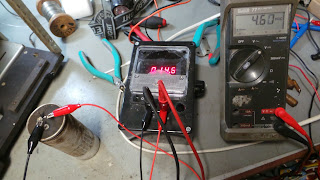Now, on his last visit from Wales, my friend David dropped in a Sony 9-90UB in a bag. It's a dual-standard (405/625) 9" black and white set, made from about 1969 to 1972. It's fully transistorised, and can run off a 12V battery if required. There's a continental version, the 9-90UM, which is UHF/VHF and has 625 and 819 lines for France and Belgium. Quite why Sony developed a 405 version so late into the game seems strange, but I suppose VHF reception was better for a portable set (?) There's also a dodge for getting 625 reception on this set on VHF, and that's to gently press the 405 button so the 625 button pops out, but leaving the 405 button un-latched. I watched some Spanish TV in the early 90's via sporadic-e reception on just it's telescopic aerial!
anyway ...
"It's in bits, I had a go at fixing it...."
Fixing it? A Sony 9-90? Surely not. These sets are the most reliable in existence. I've seen dozens over the years, and, well, they just work..... Normally, if you get a vintage TV in, the last thing you do is connect it to the mains, well, with these that's exactly what you do, and they just work. Scratchy pots are the norm, but other than that, they're perfect...
... not this one.
 A bit of an ominous warning on the mains plug ...
A bit of an ominous warning on the mains plug ...A selection of screws, knobs and trim parts....
Anyway... I'll take some shots of it, because I've never had the need to take one apart before!!
This is the power supply, It's mounted in the back. Don't undo the two screws holding the mains transformer to the back, take the back off with it in situ.
Compact chassis... wiring everywhere. Typical high quality Sony late 60's construction.
PCB....
Anyway, having checked there's nothing disconnected, and nothing looking too bad, I throw caution to the wind, remove David's "DO NOT PLUG IN" label, and plug it in, via an isolated variac.
 Giving it 240 of Her Majesty's finest English volts , and nothing .... the set isn't drawing any current, so I check the fuses and mains switch, and all prove their innocence. I check mains is getting to the transformer (it is), and then check the output. Nothing. The transformer is open circuit. I then notice some wax has been melting from the transformer. It's been hot. A check on the bridge rectifier shows this to be short circuit.
Giving it 240 of Her Majesty's finest English volts , and nothing .... the set isn't drawing any current, so I check the fuses and mains switch, and all prove their innocence. I check mains is getting to the transformer (it is), and then check the output. Nothing. The transformer is open circuit. I then notice some wax has been melting from the transformer. It's been hot. A check on the bridge rectifier shows this to be short circuit.
To prove the rest of the set, I disconnect the output from the rectifier and connect the bench power supply....
... and at 12V, the set springs into life, and gives some results on 405 ....
.... and 625 lines. The set is drawing about 900mA from the bench supply. I look around the workshop for a suitable transformer, but I've got nothing that will supply enough current and fit in the hole....
Then I remember I bought a small switched mode supply, capable of 2A... just the job. Now these are available on eBay, but be careful when buying, as some lack the most basic of mains filtration, and are really not fit for purpose. I got a box of these from a reputable supplier. They produce almost no RFI. I connect it up to the set to prove it out...
... and once I'm happy, I mount it in place of the original transformer.
A quick check again... 405...
625....
The guilty parties....
All buttoned back up and given a soak-test for a couple of hours. It's missing the VHF channel select knob, which David seems to think is "in the living room somewhere"
And here, just to embarrass my brother Rob, is him sat in front of one back in the 80's...
... nice curtains ...
... and here's Nik-Nak's "Colour" 9-90's from the 1974 James Bond film "The Man with the Golden Gun" (c) MGM












































































